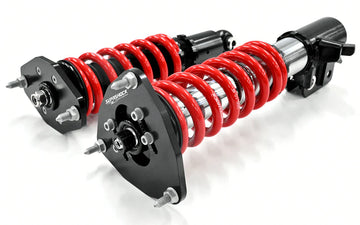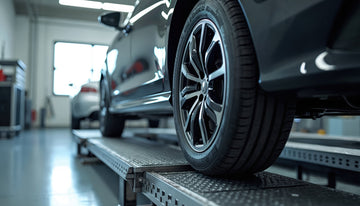Coilover technology has revolutionised many facets of driving; from high performance, to racing, to off-roading, and everything in between. Coilovers do this by enhancing a vehicle's handling and ride quality by combining coil springs and dampers to effectively control the motion of the vehicle, providing a balanced and responsive driving experience.
The science behind coilover technology is essentially the result of applying practical physics and engineering principles to enhance a vehicle's performance. The key lies in tuning the damping characteristics to suit the vehicle and its intended application. Coil springs store and release energy, while dampers manage the compression and rebound motions of the wheel and upright components, with the end result being a more controlled ride.
Important terminology
Coil Springs
Coil springs push the wheels away from the vehicle body, supporting the vehicle's weight. Compression forces during bumps compress the spring, storing potential energy. Rebound sees the spring expanding, releasing stored energy. The choice of spring rates significantly influences handling, and responsiveness.
Shock Absorbers
Shock absorbers, also known as dampers, dampen and control the motion of the wheel and upright components. They regulate the rate at which springs compress and rebound, improving handling and offering a more controlled ride. Damping force adjustment allows users to fine-tune the system based on driving conditions and preferences.
Compression
Compression in coilovers occurs when external forces compress the coil spring, with shock absorbers damping these forces. Compression adjustments enable users to customise the rate that the wheel travels upwards, providing a tailored response to different driving scenarios.
Rebound
Rebound in coilovers is when the coil spring attempts to return to its original position after compression. Shock absorbers dampen rebound forces, ensuring a controlled and stable return. Rebound adjustments allow users to fine-tune the rate that the wheel travels downwards.
Damping Rates
Damping rates in coilovers refer to the rate at which shock absorbers control spring movements (upwards and downwards motions). Adjustable damping rates allow users to customise the system's response to different driving conditions, providing flexibility for performance or comfort-oriented setups.
Spring Rates
Spring rates in coilovers represent the stiffness of coil springs, determining force requirements for compression and expansion. Higher rates can offer improved handling and towing capacity but reduced ride comfort, while lower rates provide a softer ride at the expense of handling precision. Choosing appropriate spring rates is crucial for balancing performance and comfort in a coilover setup.
Suspension Geometry
Suspension geometry refers to how a vehicle's suspension system components are arranged, impacting the positions and movements of its wheels. Key factors like camber, caster, and toe influence handling, stability, and tire wear.
- Camber - The tilt of a vehicle's wheels
- Caster - The angle of the steering axis
- Toe - The direction the wheels point
What are the features of Supashock coilovers?
Supashock coilovers have specific features that cater to specific preferences and driving needs, offering enthusiasts a range of options to enhance their vehicle's performance, aesthetics, and ride quality.
- Height Adjustability: Supashock coilovers offer users the ability to modify the ride height of their vehicle. This is popular among enthusiasts who seek versatility, allowing them to fine-tune the vehicle's stance for aesthetic preferences or performance needs. By adjusting the threaded collar on the shock body, users can raise or lower the entire suspension assembly, providing customisation without compromising performance.
- Damping Adjustability: Damping adjustability goes beyond basic height adjustments by offering control over the damping characteristics of the shock absorbers. This advanced feature allows users to tailor the suspension's response to various driving conditions.
- External Reservoir: Supashock coilovers feature an additional reservoir separate from the main shock body. This reservoir holds extra oil and gas, improving heat dissipation and performance under demanding conditions. The external design enhances the coilover's ability to handle intense driving scenarios, such as aggressive track sessions or off-road adventures, making them a popular choice among serious enthusiasts and professional racers.
- Inverted Coilovers: Inverted coilovers reverse the typical strut design and introduces an outer cylinder that enables the damper body to house more oil and a larger piston, as well as a smaller-diameter piston rod. The inverted design therefore enhances thermal and damping performance significantly. Inverted coilovers are often preferred in high-performance applications, where reducing weight and maintaining precise control over the suspension are paramount.
- Camber Adjustment: Camber adjustment allows users to modify the vehicle's camber angle, which is crucial for optimising tire contact with the road surface, improving cornering performance, and tire wear. This type of coilover is favoured by those who prioritise fine-tuning their vehicle's alignment for specific driving conditions, such as spirited driving or competitive racing.
How does the science behind coilover technology translate into real-world driving experiences?
The science behind coilover technology profoundly influences real-world driving experiences by enhancing key aspects of vehicle dynamics, including:
- Improved Handling: The optimisation of damping (compression and rebound forces) results in superior handling. Drivers experience increased stability and responsiveness, especially whilst cornering and manoeuvring through challenging road conditions.
- Enhanced Stability: The careful balance of damping rates and the management of rebound forces contribute to a more stable ride. Coilovers provide a controlled return of the suspension, minimising body roll and ensuring the vehicle maintains better stability, even during sudden manoeuvres.
- Customisable Performance: Adjustable features such as damping rates and height adjustments allow drivers to customise the suspension system according to their preferences and driving conditions. This adaptability means drivers can achieve a reasonably comfortable ride for daily commuting and switch to a firmer, more performance-oriented setup for spirited drives or track days.
- Precise Responsiveness: Drivers experience more precise control over the vehicle's movements, translating steering inputs directly into the road for a more connected and agile feel.
- Optimised Traction: Coilovers, especially those with camber adjustments, help optimise the tire contact patch with the road. This results in improved traction and cornering capabilities, particularly valuable for enthusiasts who seek heightened performance and control.
- Adaptability to Driving Conditions: The versatility of adjustable coilovers allows drivers to adapt to changing driving conditions. Whether navigating city streets, tackling rough terrain, or engaging in more intense driving, coilovers can be fine-tuned to optimise performance for each scenario.
- Reduced Brake Dive and Acceleration Squat: Coilovers help minimise brake dive during braking and acceleration squat during rapid acceleration. This contributes to a more balanced ride, improving overall vehicle dynamics and control.
- Increased Longevity of Components: The precise control over suspension movements provided by coilovers can lead to reduced wear and tear on other vehicle components. This can contribute to increased longevity and durability of various suspension elements.
What vehicle factors influence coilovers?
- Vehicle Weight: Vehicle weight influences coilover performance. Heavier vehicles demand robust coilovers with higher spring rates for optimal handling. Lighter vehicles require a nuanced approach to avoid an overly stiff suspension while ensuring comfort. Weight distribution between the front and rear impacts balance.
- Suspension Geometry: Coilovers align with specific suspension geometries, optimising tire contact for better handling. Adjustable features fine-tune parameters like camber and toe, enhancing customization for desired handling characteristics.
- Drivetrain Configuration: Drivetrain type (FWD, RWD, AWD) affects weight distribution. Coilover tuning must align with drivetrain specifics to maintain balance and traction.
- Ride Height Preferences: Coilovers with adjustable height cater to individual preferences, offering a range from lowered to lifted stances.
- Tire Size and Wheel Setup: Coilovers must accommodate tire and wheel choices, ensuring optimal dynamics, ride comfort, and proper clearance.
- Alignment Adjustments: Alignment features in coilovers enable precise control over camber, caster, and toe, enhancing handling and tire longevity.
- Braking System Upgrades: Coilovers complement braking upgrades, providing support and responsiveness to changes in weight distribution during braking.
Where can I learn more about the science behind coilover technology?
If you are interested in diving deeper into the world of coilover technology, there is a wealth of resources available. Not only can you find information on coilovers, but you can also join communities full of automotive enthusiasts.
We recommend you check out the following:
- Manufacturer Websites: Visit the official websites of coilover manufacturers. They often provide detailed information about their products, including specifications, technologies used, and application guides.
- Automotive Forums: Explore automotive enthusiast forums such as Reddit's r/cars or dedicated platforms like the Coilovers section on CivicX or VWVortex. Engaging with the community can offer real-world insights and experiences.
- Online Automotive Publications: Websites like MotorTrend, Car and Driver, or Road & Track often publish in-depth articles and reviews about suspension technologies, including coilovers.
- YouTube Channels: Tune in to automotive YouTube channels that specialise in technical content. Channels like Engineering Explained or Hoonigan often feature videos explaining the science behind various automotive technologies, including coilovers.
- Technical Books and Manuals: Look for technical books related to automotive suspension systems or manuals provided by coilover manufacturers. These resources delve into the engineering principles and design considerations.
- Educational Platforms: Explore online educational platforms like Khan Academy or Coursera, which may offer courses on automotive engineering or vehicle dynamics, providing a theoretical understanding of coilover technology.
- Automotive Magazines: Magazines like Hot Rod, Grassroots Motorsports, or Performance VW often feature articles that dive into the technical aspects of aftermarket suspension systems, including coilovers.
- Local Car Enthusiast Meets: Connect with local car enthusiast groups or attend car meets. Engaging with fellow enthusiasts can lead to valuable discussions and firsthand experiences with different coilover setups.
- Online Reviews and Comparisons: Read user reviews on retailer websites and forums to understand how different coilovers perform in real-world scenarios. Comparative reviews can help you evaluate various options and make informed decisions.





